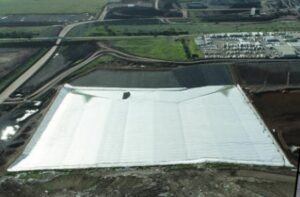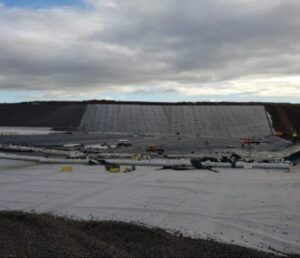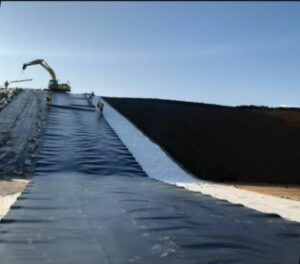Community members said they were amazed at how much interactive layering is involved in constructing a cell. They also appreciated the openness and transparent overview of what takes place within a Cleanaway landfill site.
Community members said they were amazed at how much interactive layering is involved in constructing a cell. They also appreciated the openness and transparent overview of what takes place within a Cleanaway landfill site.
Melbourne Regional Landfill (MRL) is a highly engineered landfill and plays an important role in Victoria’s waste management strategy. The site covers over 200 hectares and takes in 1.9 million tonnes of waste each year. As Victoria’s largest landfill, it is essential that MRL is always performing at the highest standard.
Engineering Manager Alaa Abou-Antoun explains what it takes to build a new cell at Australia’s business landfill.
The engineering team at Melbourne Regional Landfill is proud to present our latest Cell 4C1 which was approved and licensed to comply with EPA Best Practice Environmental and Management (BPEM) requirements. Being the busiest site in Australia, if not the southern hemisphere, we must maintain peak performance by ensuring the best liner materials, design and optimisation is achieved not just from compliance and environmental perspective, but also in a tough competitive market.

Pictured: Aerial north facing view of Cell 4C1 at Melbourne Regional Landfill
The site footprint is in excess of 200Ha and it receives 1.9M tonnes annually, meaning the engineering team is constantly on the move to plan ahead of operations. Cells are carefully engineered sections within the landfill that eliminate any potential environmental impacts through a premium grade composite liner system. We plan up to three years in advance to ensure best practice design and construction is implemented. There are no short cuts so good, smart solutions depend heavily on time invested and time needed to implement the solution.
Every project has its challenges, that’s a given. Cell 4C1 commenced with an added red flag immediately knowing the cell construction duration was spanning the peak winter months. The cell liner material is heavily impacted by wind and rain, so works would need to stop if the liner integrity was to be compromised by weather. Working through winter means the risk of having to slow or stop work is high, leading to potential project delays and cost overruns. Shortly after construction had started, the unfortunate outbreak of Covid-19 added yet another major risk not just to the project, but many lives were potentially at stake.

Pictured: HDPE cushioning being placed on the cell
Through strategic planning, agility and a Cleanaway safety mindset, the cell was completed on time and within budget. One of the key measures taken to manage safety health concerns on-site was added offices and lunchrooms to allow adequate isolation between teams and personnel. While unpredictable weather meant there were times when late nights and weekend work was required to meet milestone targets and protect exposed liner from potential damage due to adverse weather conditions. Ultimately, it was these judgment calls on the ground that kept the project critical path in check and ensured final practical completion date was met.
Maintaining compliance with EPA BPEM is a proud achievement as it supports Cleanaway’s mission statement of making a sustainable future possible. Our greatest achievement is maintaining the highest standard cell design and construction while also remaining the most competitive in the market from both cost and construction timing perspective. As engineers, we strive through continuous improvement to optimise and innovate practical solutions.

Pictured: A close up view of works on the cell
It was great to receive positive feedback from the local community when the engineering team presented illustrative slides and aerial photos of the site works and production to date. Specifically, community members said they were amazed at how much interactive layering is involved in constructing a cell. They also appreciated the openness and transparent overview of what takes place within a Cleanaway landfill site.
On a personal level, I feel proud working for Cleanaway has and the way they supported my decisions along the way to maintain compliance and the highest standard cells at MRL.
The key objectives in constructing the cell include:
- Designing cells that are of highest quality to meet EPA BPEM standard and requirements.
- Design optimisation to ensure base grading minimises cut/fill volumes. This avoids excessive time to transport material by strategically placing sumps in naturally occurring low points on-site. It not only saves cost in cell construction and timelines but has an added benefit to the environment by reducing the volume of material that needs to transported by trucks.
- Design optimisation to maximise airspace within a fixed cell boundary. This is achieved by looking at methods to steepen slopes where practicable and safe to do so as well as looking at base liner materials that achieve same design intent while using less material thickness. Steepening the site contours has an environmental benefit by allowing stormwater to shed off rather than remain on the landfill surface for extended periods.
- Cell area and airspace must provide min. 6-month buffer ahead of waste operations and provide no more than 2 years airspace capacity.
- Ground water is reviewed, and the base of cells is set min. 2.0m clean fill above to protect the environment and maintain compliance with EPA BPEM and Licence.
Cleanaway’s project team consisted of:
- Head of Engineering Barry Griffin
- VIC Engineer Manager and Project Director Alaa Abou-Antoun
- Project Engineer Oscar Henderson
- Shamrock Civil & Environmental (Contractor)
- Peter J Ramsay and Associates (EPA Appointed Environmental Auditor)
- Ricardo Energy, Environment and Planning (Geotechnical Inspection and Testing Authority)
Contact us to learn more about how we are making a sustainable future possible for communities and businesses across Australia.